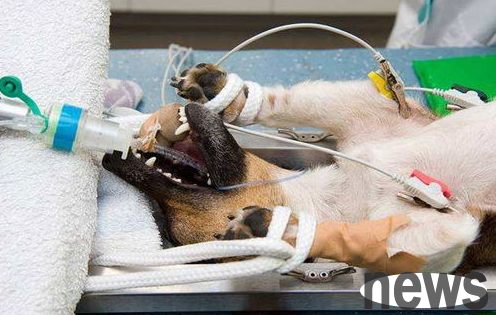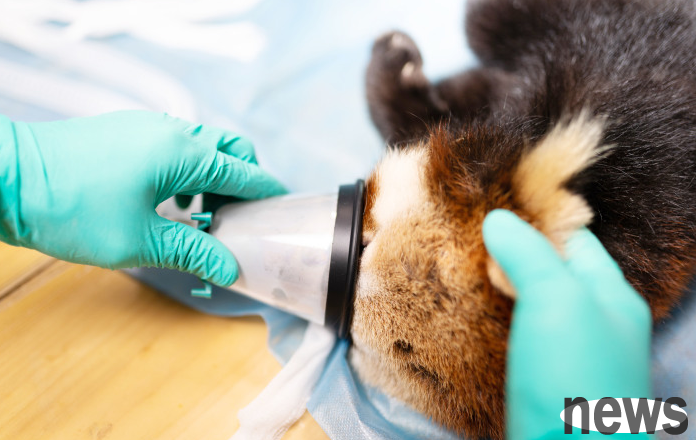The overall awareness and technical level of the domestic pet medical industry have been greatly improved. Most hospitals and clinics have undergone respiratory anesthesia. So is it safe and you can worry-free?
1. Why do you need anesthesia?
Pets not only need surgery when they are sick or injured, but they often face surgical operations. The most common surgery is sterilization surgery. Some dogs also have to undergo cosmetic surgery such as tail breaking, ear erecting, dental cleaning surgery. No matter the size of the operation, anesthesia is required. At this time, the doctor will tell us that there are risks in anesthesia and we also need to sign it. We can’t help but feel nervous and afraid. Why are there any risks in performing a minor operation?

2. What are the categories of anesthesia?
Anesthesia can be divided into local anesthesia and general anesthesia, and general anesthesia is divided into injection anesthesia and inhalation anesthesia. Generally speaking, the greatest risk of anesthesia is injection anesthesia, and inhalation anesthesia is relatively safe. Local anesthesia is safest. The "lumbar anesthesia" widely used in human medicine is also a type of local anesthesia, but it is rarely used in veterinary clinical practice, because this anesthesia is hemiplegia, the brain consciousness is clear, the upper limbs and head can also be moved, and dogs have no control over humans, and in most cases they will not cooperate with the doctor's surgery. Therefore, most of the pet's surgery is a general anesthesia method.
3. What is general anesthesia?
refers to the inhalation of anesthetic drugs into the body through the respiratory tract, intravenous or intramuscular injection, resulting in temporary inhibition of the central nervous system. It is clinically manifested as disappearance of consciousness, disappearance of systemic pain, forgetting, reflex inhibition and skeletal muscle relaxation. The extent of central nervous system depression is related to the concentration of drugs in the blood and can be controlled and regulated. This inhibition is completely reversible. When the drug is metabolized or excreted from the body, the function of the body returns to normal in all aspects.
4. What are the risks of general anesthesia?
1. Cardiovascular problems such as bradycardia, heart rate arrhythmia, cardiopulmonary arrest. The probability of these problems in older pets is relatively high.
2. Respiratory tract obstruction and pulmonary edema. Some specific breeds such as bullfighting, lion Chow, starlings, etc. are very prone to this problem due to their physiological structure.
3. Acute renal failure, anesthesia of pets with chronic renal insufficiency can be dangerous.

4. After anesthesia, this disease is hereditary and is often found in muscular male dogs. The symptoms are fever and tachycardia leading to death after inhalation anesthesia for 30 minutes to several hours.
5. How to reduce this risk?
1. The first thing is to choose a pet hospital with advanced equipment and complete procedures. The hospital has sufficient doctors and it is safer to have a dedicated person to be responsible for anesthesia monitoring during surgery.
2. Choose respiratory anesthesia. Respiratory anesthesia is gas anesthesia. Anesthetic drugs enter the body through gas, and the anesthesia effect is fast and metabolized quickly. It has little effect on cardiovascular and respiratory inhibition. It is now recognized as the safest anesthesia method. In contrast, injection anesthesia is injecting drugs into the body, which may have a certain inhibitory effect on respiration and cardiovascular. Drugs for injecting anesthesia are also divided into imported anesthetics and domestic anesthetics. Now, domestic anesthetics are not safe and have basically been eliminated. Although imported anesthesia is highly safe, due to the restrictions on national approval, they can only rely on purchasing agents and other means to enter the country, and the supply is unstable.
3. Be sure to conduct relevant examinations before the operation. We will not notice many potential diseases, because dogs or cats do not have any obvious symptoms and can only find problems through instruments and equipment. Before the operation, doctors will recommend checking biochemical and blood routine and electrocardiograms, which is definitely not to charge more, but to increase the safety of anesthesia. The main organs for examination include the heart, kidneys, etc. If chronic heart and kidney disease is not detected, the risk after anesthesia will be very dark to rescue.
4 Follow the doctor's advice and the doctor will inform you that feeding is prohibited 12 hours before anesthesia and drinking water is prohibited for 8 hours. This must be followed, and you cannot be lucky. Once vomiting occurs during anesthesia, vomiting can cause suffocation and death.
6. View the risk of anesthesia correctly. Anesthesia has risks, but it must be treated scientifically and rationally and operated according to the procedures. This risk is actually very low. Even hospitals with large outpatient volumes may only encounter once or no anesthesia accidents in several years. The surgery that should be performed must be performed in time and you cannot give up on your food due to choking.